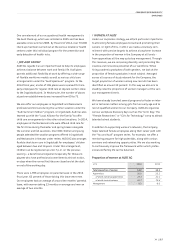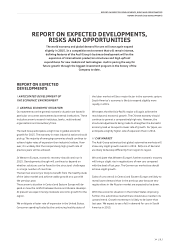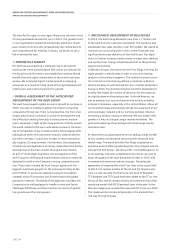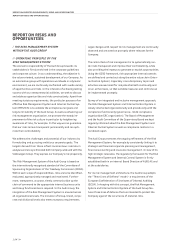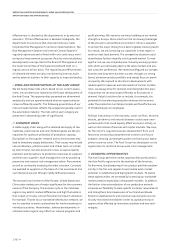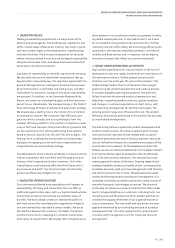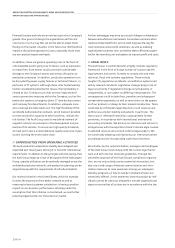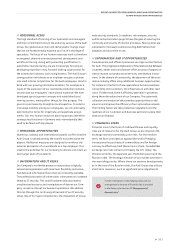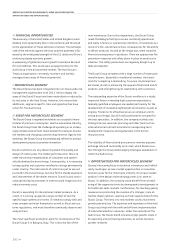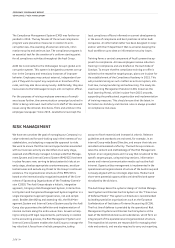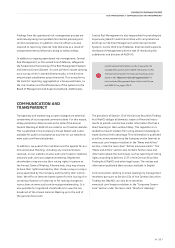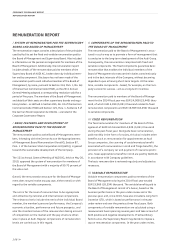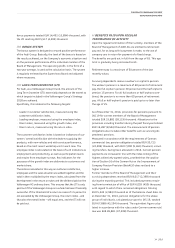Audi 2014 Annual Report Download - page 199
Download and view the complete annual report
Please find page 199 of the 2014 Audi annual report below. You can navigate through the pages in the report by either clicking on the pages listed below, or by using the keyword search tool below to find specific information within the annual report.
REPORT ON EXPECTED DEVELOPMENTS, RISKS AND OPPORTUNITIES
REPORT ON RISKS AND OPPORTUNITIES
>>
199
//
INDUSTRY RISKS
Meeting sustainability requirements is a major driver of the
political and social agenda. The resulting laws, regulations and
shifts in social values influence our industry. COĊ limits in partic-
ular have a direct impact on the development, manufacturing
and sale of vehicles. The principal consequences for the auto-
motive industry are that it must assume ecological responsibility
along the entire value chain, and above all strive to reduce fuel
consumption and vehicle emissions.
Audi takes its responsibility to meet COĊ requirements seriously.
We also take into account stakeholder expectations that go
beyond what is required by law. The objectives agreed with the
Board of Management are managed at brand and Group level
by central functions, committees and work groups, and their
implications for economic, ecological and social responsibility
are assessed. In addition, in the Corporate Responsibility
Report, we render our sustainability goals and activities trans-
parent for our stakeholders. We manage change in the field of
drive technology through our product and powertrain strategy.
We already play a leading role in the industry for convention-
al combustion engines. We champion high-efficiency, pro-
gressive vehicle concepts and use technologies from the
modular efficiency platform. This platform comprises a wide
array of technical solutions that ensure efficient products. We
are also working hard on refining alternative drive systems
based on electric, hybrid, fuel cell and CNG technologies. The
findings from sustainability assessments and stakeholder
dialogues for gauging current and future expectations are
integrated into our sustainability strategy.
The development of the industry worldwide is characterized by
intense competition that manifests itself through price posi-
tioning or the increased use of sales incentives. Its further
intensification could adversely affect the Audi Group and re-
duce revenue and profit. Our brand strength and attractive
product portfolio help mitigate this risk.
//
INDUSTRY OPPORTUNITIES
Our customers worldwide have expectations with respect to
sustainability, efficiency and connectivity that can offer us
additional opportunities. Here, both our sophisticated vehicles
and services as well as new services are potential areas of
business. We have already created an established platform
with Audi connect for translating the megatrends of digitiza-
tion and connectivity into viable business models. We act as
the interface between the customer, the dealer, the vehicle
and the environment in adapting our products and services
continually to requirements. We already offer innovative assis-
tance systems in our production models as a gateway to realiz-
ing added market potential. In the medium term, we intend
for our piloted driving systems to be instrumental in further
improving not just traffic safety, but also energy efficiency and
convenience. We have also identified potential in the field of
mobility and fleet services and, in response, are developing
innovative concepts that reflect our premium standards.
//
RISKS FROM OPERATING ACTIVITIES
High upfront expenditures for future products in the form of
development costs and capital investments are key features of
the automotive industry. Yet the payback period usually
stretches over the multi-year life cycle of the products. This
fundamentally harbors the risk of deviations from project
goals during the product development and creation process.
It includes outdated planning assumptions, the potential
failure to achieve the planned product characteristics and
objectives, impending deadline overruns, quality variations
and changes in customer expectations at short notice, with
corresponding consequences for the financial targets. The
growing product range also influences this risk. The product
definition and product positioning in the market may also lead
to unscheduled developments.
The Audi Group follows a systematic product development and
product creation process. It involves a wide range of manage-
ment and control instruments that validate both a project’s
milestone-based maturity and its financial objective. New prod-
ucts are defined on the basis of a comprehensive analysis of the
environment and customers. In the development phase that
follows, we use our extensive development and supplier network
to bring the vehicle project to production maturity efficiently
and in line with premium standards. This simultaneous engi-
neering approach involves all divisions. Ongoing target/actual
analyses, feasibility studies and quality checks, accompanied by
escalation processes right up to top management, hold financial
and technical project risks in check. Despite extensive market
studies and thorough project planning and management, it is
ultimately not entirely possible to ensure the market success of
new vehicle projects, technologies or services. We also work
continually to improve our product characteristics after market
launch, to keep delighting our customers in the long term. Our
market success and the expansion of our product portfolio ne-
cessitate the ongoing refinement of our organizational struc-
tures and processes. The main profit and cost drivers are man-
aged and monitored by our Controlling area and as a product
management task. The ratios applied are for project-based
cost and profit management, and for corporate financial
management.


